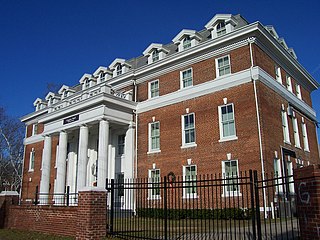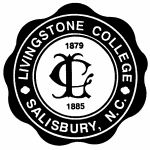
The Central Intercollegiate Athletic Association (CIAA) is a college athletic conference affiliated with the National Collegiate Athletic Association (NCAA) at the Division II level, whose member institutions consist entirely of historically black colleges and universities (HBCUs).

The Southern Intercollegiate Athletic Conference (SIAC) is a college athletic conference affiliated with the National Collegiate Athletic Association (NCAA) at the Division II level. Formed in 1913, it consists mostly of historically black colleges and universities (HBCUs), with all but one member located in the Southern United States.

Salisbury is a city in the Piedmont region of North Carolina, United States; it has been the county seat of Rowan County since 1753 when its territory extended to the Mississippi River. Located 25 miles (40 km) northeast of Charlotte and within its metropolitan area, the town has attracted a growing population. The 2020 census shows 35,580 residents.

Tuskegee University is a private, historically black land-grant university in Tuskegee, Alabama. It was founded on Independence Day in 1881 by the Alabama Legislature.
Historically black colleges and universities (HBCUs) are institutions of higher education in the United States that were established before the Civil Rights Act of 1964 with the intention of primarily serving African Americans. Most of these institutions were founded during the Reconstruction era after the Civil War and are concentrated in the Southern United States. They were primarily founded by Protestant religious groups, until the Second Morill Act of 1890 required educationally segregated states to provide African American, public higher-education schools in order to receive the Act's benefits.

North Carolina Agricultural and Technical State University is a public, historically black, land-grant research university in Greensboro, North Carolina. It is a constituent institution of the University of North Carolina System. Founded by the North Carolina General Assembly on March 9, 1891, as the Agricultural and Mechanical College for the Colored Race, it was the second college established under the provisions of the Morrill Act of 1890, as well as the first for people of color in the State of North Carolina. Initially, the college offered instruction in agriculture, English, horticulture and mathematics. In 1967, the college was designated a Regional University by the North Carolina General Assembly and renamed North Carolina Agricultural and Technical State University.

The African Methodist Episcopal Zion Church, or the AME Zion Church (AMEZ) is a historically African-American Christian denomination based in the United States. It was officially formed in 1821 in New York City, but operated for a number of years before then. The African Methodist Episcopal Zion Church adheres to Wesleyan-Arminian theology.

Grambling State University is a public historically black university in Grambling, Louisiana. Grambling State is home of the Eddie G. Robinson Museum and is listed on the Louisiana African American Heritage Trail. Grambling State is a member-school of the University of Louisiana System and Thurgood Marshall College Fund.

Stillman College is a private historically black Presbyterian college in Tuscaloosa, Alabama. It awards Bachelor of Arts and Bachelor of Science degrees in 22 programs housed within three academic schools. The college has an average enrollment of 728 students and is accredited by the Southern Association of Colleges and Schools.

Benedict College is a private historically black college in Columbia, South Carolina. Founded in 1870 by northern Baptists, it was originally a teachers' college. It has since expanded to offer majors in many disciplines across the liberal arts. The campus includes buildings in the Benedict College Historic District, a historic area listed on the National Register of Historic Places.

Allen University is a private historically black university in Columbia, South Carolina. It has more than 600 students and still serves a predominantly Black constituency. The campus is listed on the National Register of Historic Places as Allen University Historic District.
Voorhees University is a private historically black university in Denmark, South Carolina. It is affiliated with the Episcopal Church and accredited by the Southern Association of Colleges and Schools.

The Johnson C. Smith Golden Bulls are the athletic teams that represent Johnson C. Smith University, located in Charlotte, North Carolina, in intercollegiate sports at the Division II level of the National Collegiate Athletic Association (NCAA), primarily competing in the Central Intercollegiate Athletic Association since the 1926–27 academic year.
The Livingstone Blue Bears football program is an intercollegiate American football team for Livingstone College located in Salisbury, North Carolina. The team competes in NCAA Division II as a member of the Central Intercollegiate Athletic Association (CIAA). The school's first team was fielded in 1892 as the first historically black college to play football. The team plays its home games at Alumni Memorial Stadium.

The Tuskegee Golden Tigers represent Tuskegee University in intercollegiate athletics. They are a member of the National Collegiate Athletic Association (NCAA) Division II and compete within the Southern Intercollegiate Athletic Conference (SIAC). The university has a total of 10 varsity sports teams, five men's teams called the "Golden Tigers", and five women's teams called the "Tigerettes".

Hood Theological Seminary is a Christian seminary sponsored by the African Methodist Episcopal Zion Church in Salisbury, North Carolina. It is a graduate and professional school sponsored by the African Methodist Episcopal Zion Church and approved by the University Senate of The United Methodist Church. From its founding in 1879 until 2001, the seminary was part of Livingstone College; it is now independent. The seminary is accredited by the Association of Theological Schools in the United States and Canada.

James Walker Hood was an African Methodist Episcopal Zion Church bishop in North Carolina from 1872 to 1916. Born and raised in Pennsylvania, he moved to New York and became active in the AME Zion church. Well before the Emancipation Proclamation, he was an active abolitionist.

Joseph Charles Price was a founder and the first president of Livingstone College in Salisbury, North Carolina. He was one of the greatest orators of his day and a leader of African Americans in the southern United States. His death at the age of 39 cut short a career that might otherwise have vied with that of Booker T. Washington.




















